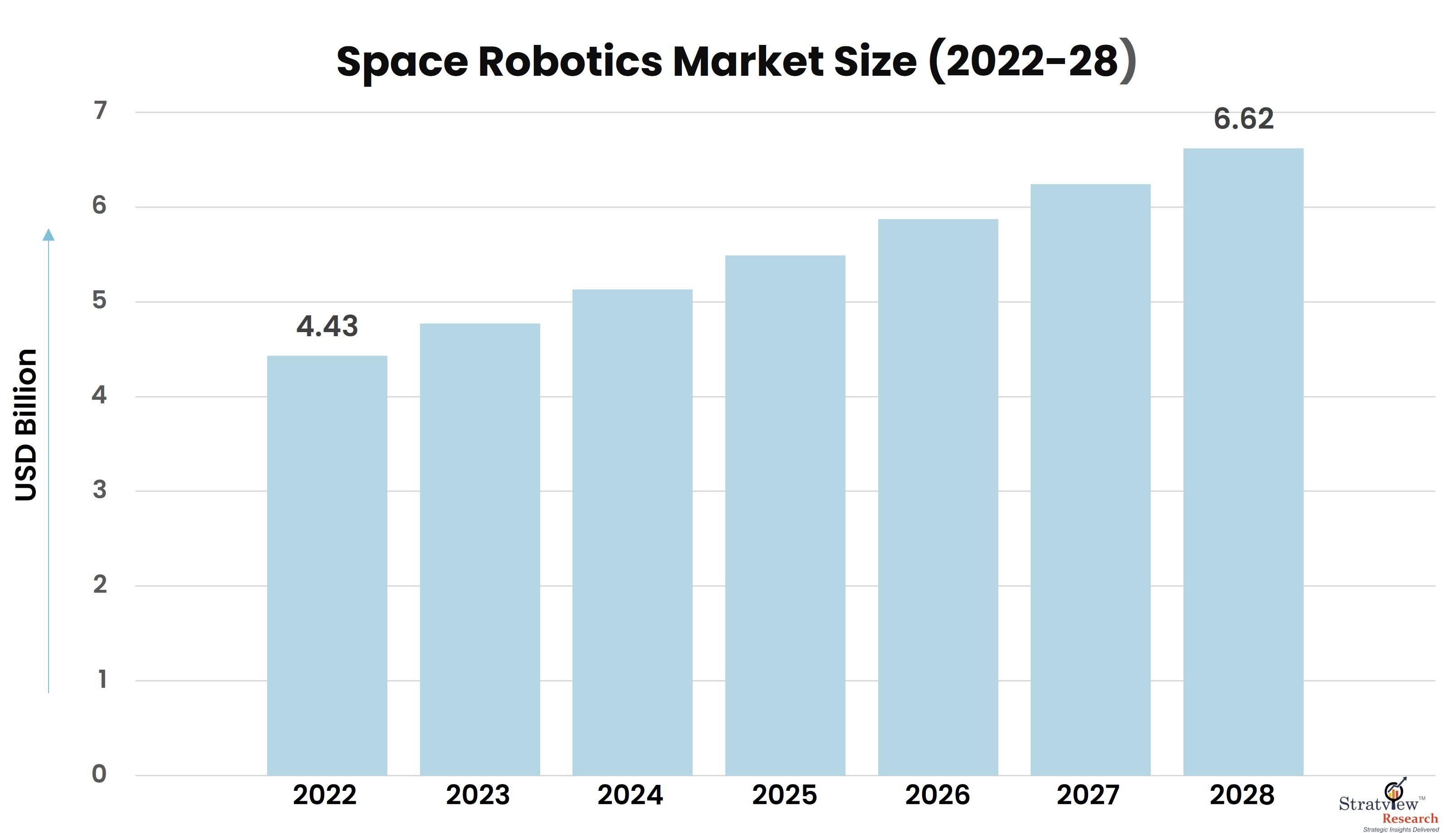The space robotics market is evolving rapidly, driven by a combination of technological advancements, strategic investments, and changing industry needs. These dynamics are shaping the future of space exploration and utilization, influencing the development and deployment of robotic systems. In this article, we explore the key market dynamics that are shaping the future of space robotics, examining how they interact and contribute to the growth and transformation of the industry.
According to Stratview Research. the space robotics market was estimated at USD 4.43 billion in 2022 and is likely to grow at a CAGR of 6.77% during 2023-2028 to reach USD 6.62 billion in 2028.
Technological Innovations
1. Artificial Intelligence and Machine Learning
Artificial Intelligence (AI) and Machine Learning (ML) are at the forefront of technological innovations in space robotics. These technologies enable robots to perform complex tasks autonomously, such as navigation, data analysis, and decision-making in unpredictable environments. The integration of AI and ML enhances the operational efficiency of space missions, allowing for more sophisticated and independent robotic systems that can adapt to new challenges without direct human intervention.
2. Advanced Manufacturing Techniques
Advanced manufacturing techniques, including 3D printing and additive manufacturing, are revolutionizing the production of space robots. These methods allow for the creation of lightweight, durable components that can be customized for specific missions. On-orbit manufacturing, where robots build and repair structures directly in space, is becoming a reality, reducing the cost and complexity of space missions and enabling the construction of larger, more complex space infrastructure.
Strategic Investments
1. Government Funding and Policies
Governments around the world are recognizing the strategic importance of space robotics and are increasing their funding for research and development. Space agencies like NASA, ESA, and CNSA are investing in robotic technologies for exploration, satellite servicing, and planetary defense. Government policies and initiatives aimed at promoting space exploration and maintaining technological leadership are providing the necessary support and incentives for the growth of the space robotics market.
2. Private Sector Involvement
The private sector is playing a crucial role in the advancement of space robotics. Companies such as SpaceX, Blue Origin, and Astrobotic are investing heavily in robotic technologies to support their ambitious space missions. The influx of private capital is accelerating innovation, driving down costs, and fostering competition in the market. Venture capital firms are also funding startups that are developing cutting-edge robotic solutions, further boosting the industry's growth.
Changing Industry Needs
1. Demand for Satellite Servicing
The increasing number of satellites in orbit and the need to extend their operational lifespans are driving the demand for satellite servicing. Robotic systems capable of performing tasks such as refueling, repairing, and upgrading satellites are becoming essential. These capabilities help to reduce the frequency of costly satellite replacements and manage space debris by maintaining existing assets.
2. Planetary Exploration and Colonization
Space robotics is critical for planetary exploration and the long-term goal of colonizing other planets. Robots are used for scouting, collecting samples, and conducting scientific experiments on celestial bodies such as Mars and the Moon. The data gathered by these robotic missions informs future manned missions and helps to lay the groundwork for establishing human presence beyond Earth.
3. Space Mining
The concept of space mining is gaining traction as a viable means of accessing valuable resources from asteroids and other celestial bodies. Robotic systems designed for space mining can extract and process these resources, supporting space missions and potentially bringing materials back to Earth. This emerging industry presents significant opportunities for growth and innovation in space robotics.
Emerging Trends
1. Autonomous Space Operations
The trend towards greater autonomy in space operations is gaining momentum. Autonomous robotic systems that can operate independently for extended periods are essential for deep space missions where communication delays make real-time control impractical. These systems can perform tasks such as navigation, data collection, and maintenance without human intervention, increasing the efficiency and feasibility of long-duration missions.
2. On-Orbit Assembly and Construction
On-orbit assembly and construction are becoming increasingly important for building large-scale space structures. Robots capable of assembling and maintaining infrastructure in space reduce the need for launching fully assembled components from Earth. This capability is crucial for constructing space habitats, solar power stations, and other large structures that support long-term space exploration and utilization.
3. Space Tourism
As space tourism becomes a reality, there will be a growing need for robotic systems to support space infrastructure. Robots will be used for constructing and maintaining space hotels, orbital stations, and other facilities, ensuring the safety and comfort of space tourists. This new market segment presents exciting opportunities for the development and deployment of advanced robotic technologies.
Conclusion
The future of space robotics is being shaped by a combination of technological innovations, strategic investments, and changing industry needs. As AI, advanced manufacturing, and autonomous operations continue to evolve, they will drive the development of more sophisticated and capable robotic systems. Government support and private sector involvement will provide the necessary funding and incentives for growth, while the increasing demand for satellite servicing, planetary exploration, and space mining will create new opportunities. By understanding and leveraging these market dynamics, stakeholders can navigate the complex landscape of the space robotics industry and contribute to its continued advancement.


